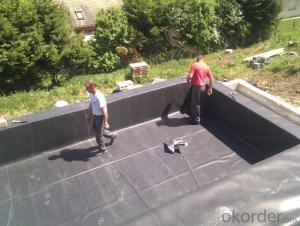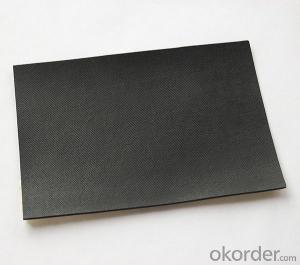EPDM Waterproof Rubber Membrane for Pond Liner
- Loading Port:
- Shanghai
- Payment Terms:
- TT OR LC
- Min Order Qty:
- 20000 m²
- Supply Capability:
- 5000000 m²/month
OKorder Service Pledge
OKorder Financial Service
You Might Also Like
EPDM Waterproof Rubber Membrane for Pond Liner
Description Of EPDM Waterproof Rubber Membrane for Pond Liner:
1. EPDM waterproof membrane is made from ternary ethylene-propylene rubber, which is for waterproofing of exposed and non-exposed applications.
2. EPDM waterproof membrane production adopts the world-advanced equipment of cold feeding extrusion and continuous vulcanization technology.
3. EPDM waterproof membrane is of high elasticity among high polymer waterproof materials and becomes a world-popular waterproofing material.
Main Features of EPDM Waterproof Rubber Membrane for Pond Liner:
1.Excellent anti-aging performance, service life can reach 50 years;
2.High elongation, high tensile strength, heat treatment size change small;
3.Plant root penetration resistance is good
4.Good low temperature flexibility
5.Application is convenient, overlapping is firm and reliable, no environmental pollution;
6. Resistance to chemical corrosion, can be applied to special places;
7.Maintenance is convenient, the cost is low
Specifications of EPDM Waterproof Rubber Membrane for Pond Liner:
ITEM | STANDARO REQUEST | |
Tensile strength at breaking,normal temperature,Mpa | ≥7.5 | |
Elongation at breaking, % | ≥450 | |
Tearing strenght,KN/m | ≥25 | |
Bending at low temperature | ≤-40°C | |
Water impermeability,0.1Mpa×30min | Impermeability | |
Hot air aging 80°C×168h | Unchanging of tensile strength at breaking,% | ≥80 |
Unchanging of elongation at breaking,% | ≥70 | |
Appearance of 100% elongation | No crack | |
Property of anti alkali 10% Ca(OH)2×168h normal temperature | ≥80 | |
≥80 | ||
Applications of EPDM Waterproof Rubber Membrane for Pond Liner:
1.Roofs, Basement, Toilets
2. Industrial and civil building waterproofing
3. Geosynthetic liner for swimming pool, channels, irrigation system
4. Especially suitable for projects with high requirements in durability, anti-corrosion and deformation.

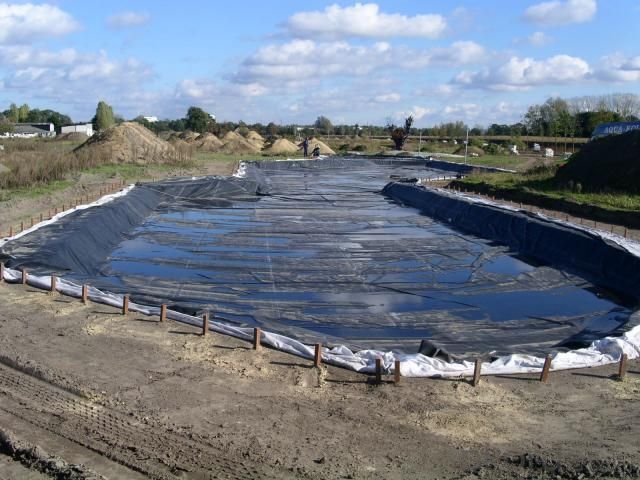

IMages of EPDM Waterproof Rubber Membrane for Pond Liner:
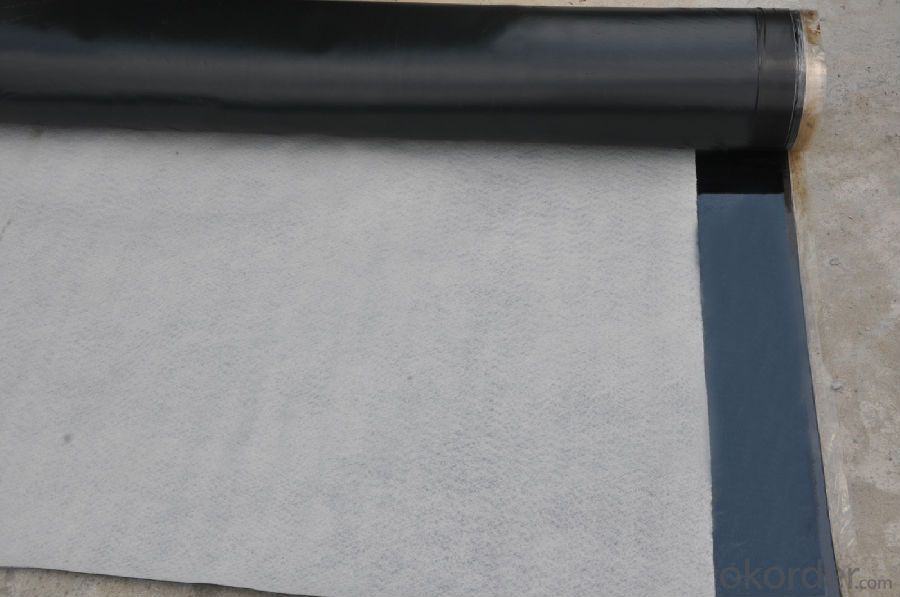
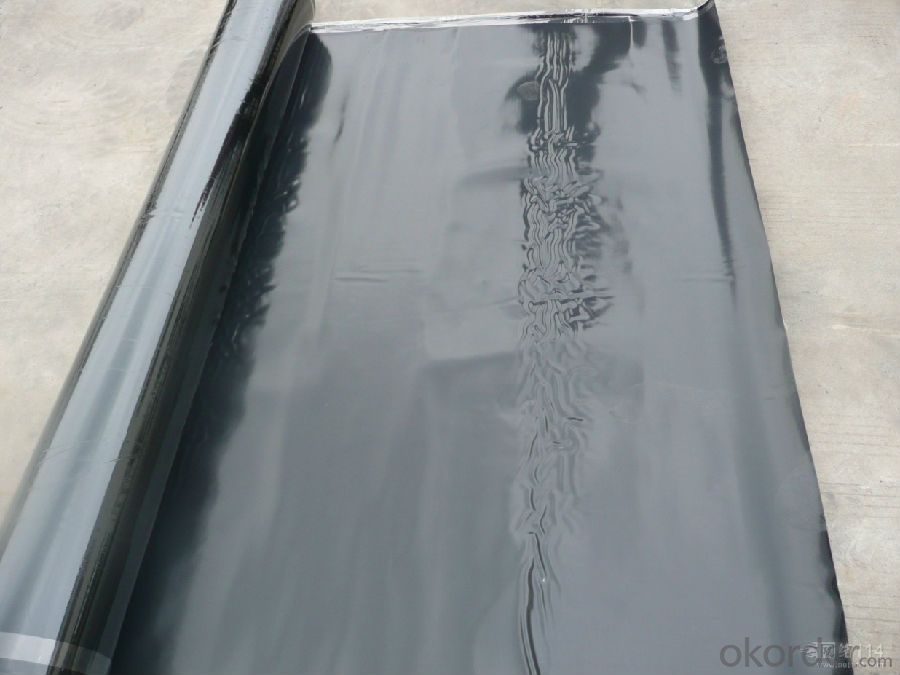


FAQ of EPDM Waterproof Rubber Membrane for Pond Liner:
1. What are we supplying?
We are specialized in producing Colorful Asphalt Roof Shingle, SBS/APP modified bitumen waterproof membrane, Self adhesive bitumen waterproof membrane, PVC waterproofing membrane, EPDM rubber roofing membrane, Single Component Polyurethane Waterproof Coating, and Spray Polyurea Waterproof Coating
.
2. How Many years experience do we have?
We have been exported to more than 20 countries in the past 15 years.
3. How long do we usually reply your request?
We always reply our customer within 24 hours.
- Q:Can a waterproofing membrane be used in planter boxes or raised beds?
- Yes, a waterproofing membrane can be used in planter boxes or raised beds. It can help prevent water damage to the surrounding structures and extend the lifespan of the planter boxes or raised beds. However, it is important to ensure proper drainage to prevent water from pooling and causing root rot in the plants.
- Q:Can waterproofing membranes be used on roofs with slopes?
- Yes, waterproofing membranes can be used on roofs with slopes. These membranes are designed to provide a protective barrier against water infiltration and are commonly used on roofs with varying degrees of slope to prevent leaks and water damage.
- Q:How does a waterproofing membrane handle exposure to high temperatures?
- A waterproofing membrane is designed to withstand exposure to high temperatures. It is typically made from durable materials such as bitumen, EPDM (ethylene propylene diene monomer), or PVC (polyvinyl chloride) that have high melting points and can resist heat. These materials have been specifically chosen to ensure that the waterproofing membrane does not degrade or lose its effectiveness when exposed to high temperatures. The membrane's ability to handle high temperatures is dependent on its composition and quality. High-quality waterproofing membranes are manufactured with additives and fillers that enhance their resistance to heat. These additives help the membrane maintain its integrity and prevent it from softening, melting, or becoming brittle when exposed to elevated temperatures. Furthermore, the installation process of the waterproofing membrane also plays a crucial role in its ability to handle high temperatures. Proper installation techniques, such as ensuring proper adhesion and seam sealing, are essential to maintain the membrane's effectiveness and prevent any potential damage caused by heat exposure. In summary, a waterproofing membrane is specifically designed to handle exposure to high temperatures. Its composition, quality, and installation techniques all contribute to its ability to withstand heat without degrading or losing its waterproofing properties.
- Q:3MM thick, one square meter waterproof membrane SBS price?
- 3, waterproofing membrane is mainly used for building walls, roofs, and tunnels, highways, landfills, etc., to withstand the external rain, groundwater leakage can be rolled into a roll of flexible building materials, as There is no leakage connection between the foundation of the project and the building, which is the first barrier to the whole project waterproofing and plays a vital role in the whole project.
- Q:Can a waterproofing membrane be applied over cracks or joints in a surface?
- Yes, a waterproofing membrane can be applied over cracks or joints in a surface. In fact, it is often recommended to do so in order to ensure a complete and effective waterproofing system. The membrane acts as a barrier that prevents water from seeping through the cracks or joints and causing damage to the underlying structure. However, it is important to note that the cracks or joints should be properly repaired and prepared before applying the waterproofing membrane. This may involve cleaning, filling, and sealing the cracks or joints to ensure that the membrane adheres properly and provides a continuous and watertight seal. Additionally, the type of waterproofing membrane used should be selected based on the specific requirements and conditions of the surface being treated.
- Q:Can a waterproofing membrane be used on precast nickel surfaces?
- Yes, a waterproofing membrane can be used on precast nickel surfaces. Waterproofing membranes are designed to create a barrier against moisture and prevent water penetration. They can be applied to various surfaces, including concrete, metal, and even nickel. However, it is important to ensure that the waterproofing membrane is suitable for use on nickel surfaces and is compatible with the specific type of precast nickel being used. It is recommended to consult with a professional waterproofing contractor or the manufacturer of the membrane for guidance on the specific application and to ensure proper adhesion and effectiveness of the membrane on precast nickel surfaces.
- Q:Can a waterproofing membrane be used on plaster surfaces?
- Plaster surfaces can benefit from the use of a waterproofing membrane. Due to its porous nature, plaster readily absorbs water, which can lead to damage caused by moisture. By applying a waterproofing membrane to plaster surfaces, a barrier is created to prevent water infiltration. This protective measure safeguards against problems like mold, mildew, and deterioration caused by moisture. Before applying the membrane, it is crucial to ensure the plaster surface is clean, dry, and devoid of loose or flaking material. It is also important to follow proper surface preparation and application techniques to guarantee the effectiveness and durability of the waterproofing system.
- Q:Does a waterproofing membrane require any specific cleaning or maintenance procedures?
- Yes, a waterproofing membrane does require specific cleaning and maintenance procedures. Regular cleaning of the membrane surface is necessary to remove any dirt, debris, or organic materials that may accumulate over time. It is recommended to use mild soap or detergent and a soft brush or sponge for cleaning. Additionally, periodic inspections should be conducted to check for any damage, cracks, or leaks in the membrane, which should be promptly repaired. Regular maintenance and proper care are crucial to ensure the long-term effectiveness and durability of the waterproofing membrane.
- Q:Can a waterproofing membrane be used for shipping containers or cargo holds?
- Yes, a waterproofing membrane can be used for shipping containers or cargo holds. Waterproofing membranes are designed to provide a barrier against moisture and prevent water leakage. By applying a waterproofing membrane to the interior or exterior surfaces of shipping containers or cargo holds, it can help protect the contents from water damage during transportation. This is especially important when shipping valuable or sensitive goods that can be negatively affected by moisture. Additionally, waterproofing membranes can also help prevent rust and corrosion on the metal surfaces of containers, ensuring their long-term durability and lifespan.
- Q:Can waterproofing membranes be used on stormwater management systems?
- Yes, waterproofing membranes can be used on stormwater management systems. These membranes provide a protective barrier that prevents water from infiltrating into the system, ensuring efficient and reliable stormwater management.
1. Manufacturer Overview |
|
|---|---|
| Location | |
| Year Established | |
| Annual Output Value | |
| Main Markets | |
| Company Certifications | |
2. Manufacturer Certificates |
|
|---|---|
| a) Certification Name | |
| Range | |
| Reference | |
| Validity Period | |
3. Manufacturer Capability |
|
|---|---|
| a)Trade Capacity | |
| Nearest Port | |
| Export Percentage | |
| No.of Employees in Trade Department | |
| Language Spoken: | |
| b)Factory Information | |
| Factory Size: | |
| No. of Production Lines | |
| Contract Manufacturing | |
| Product Price Range | |
Send your message to us
EPDM Waterproof Rubber Membrane for Pond Liner
- Loading Port:
- Shanghai
- Payment Terms:
- TT OR LC
- Min Order Qty:
- 20000 m²
- Supply Capability:
- 5000000 m²/month
OKorder Service Pledge
OKorder Financial Service
Similar products
New products
Hot products
Hot Searches
Related keywords
